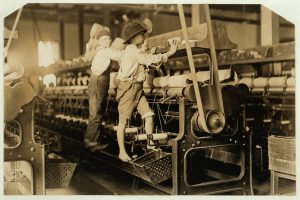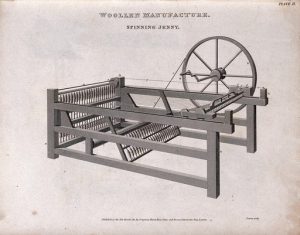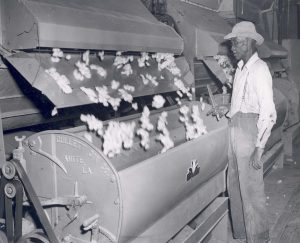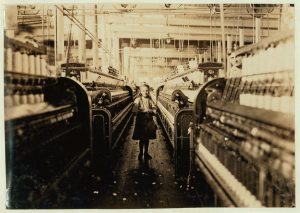One of the main industries that had benefited from the Industrial Revolution was the textile industry, involved in the design, production and distribution of yarn, cloth and clothing.

Image source: https://search.creativecommons.org/photos/9e69e25d-024c-45b7-bbb9-98fc726abcf1 by pingnews.com
The textile industry, based on the development of cloth and clothing, supplanted the old system in which the people produced goods in their own farms and sold them to local communities. In contrast, industrialization allowed the same goods to be produced in a central location and on a mass scale.
Innovations by british inventors
In 1733, John Kay developed the flying shuttle, that improved weaving efficiency and reduced labor needs because it could be operated with only one operator. James Hargreaves created the spinning jenny in 1764, which allowed a machine with many spindles of thread to be spun at one time. Richard Arkwright improved it by developing the water frame in 1769. Edmund Cartwright developed the power loom in 1785 which allowed quicker production of cloth. During the early eighteenth century, laws forbade the export of English textile machinery that would allow them to be constructed in other countries.

Image source: https://search.creativecommons.org/photos/65aa99df-2f70-4c8b-8c0c-cc89edf19a87
Innovations by American inventors

Image source: https://search.creativecommons.org/photos/49a7be0e-cf72-4a3c-83bc-3f80bc134219
In 1786, in Massachusetts, two Scotch immigrants, who claimed to be familiar with Richard Arkwright’s British-made spinning frame, were employed to design and build spinning machines for the mass production of yarn. The inventors were encouraged by the U.S. government and assisted with grants of money. The resulting machines, operated by horse power, were crude, and the textiles produced irregular and unsatisfactory. Finally, Eli Whitney developed the cotton gin in 1793, which allowed for quicker production of cotton. Previously, cotton had to be hand cleaned in order to remove fibers and seeds. Whitney’s cotton gin sped up this process and allowed for much faster harvesting of the resource.
Ready-made clothing
It was not until after the power-driven sewing machine was invented, that factory production of clothes on a large scale occurred. Before sewing machines, nearly all clothing was local and hand-sewn, there were tailors and seamstresses in most towns that could make individual items of clothing for customers. About 1831, George Opdyke began the small-scale manufacture of ready-made clothing, which he stocked and sold largely through a store in New Orleans. Opdyke was one of the first American merchants to do so. But it was not until after the power-driven sewing machine was invented, that factory production of clothes on a large scale occurred. Since then the clothing industry has grown.
How about shoes?

Image source: https://search.creativecommons.org/photos/785e17e8-d622-460b-b2f4-f932502b5604 by MIKI Yoshihito. (#mikiyoshihito)
The Singer machine of 1851 was strong enough to sew leather and was adopted by shoemakers. These shoemakers were found chiefly in Massachusetts. That variation of the sewing machine which was to do the more difficult work of sewing the sole to the upper was the invention of a mere boy, Lyman Blake, and Gordon McKay. The McKay sole-sewing machine, which they produced, came into use, and for twenty-one years was used almost universally both in the United States and Great Britain. But this was in time enlarged and greatly improved, and hundreds of other inventions have been made in the shoe industry. There are machines that split leather, make the thickness absolutely uniform, sew the uppers, insert eyelets, cut out heel tops, and many more. In fact, division of labor has been carried farther in the making of shoes than in most industries, for there about three hundred separate operations in making a pair of shoes.

Image source: https://search.creativecommons.org/photos/ac13c179-0592-4689-96a1-200d1f9d2f2e

Image source: https://search.creativecommons.org/photos/4a270b57-8ac5-4cd5-af09-c44a56af2737
Info source:
